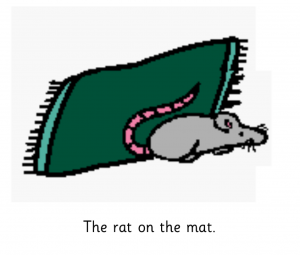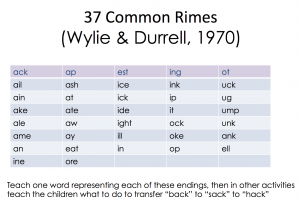As we learn to read, word recognition plays an important part in our literacy journey. Automatic word recognition is essential for fluent reading. We need to be able to recognise words quickly to be able to read quickly. However, word recognition isn't just taught via whole words. One of the ways we learn to automatically recognise words is by decoding them. Decoding helps us to memorise words so that they become automatically recognised words eventually. Decoding is also an important skill for early readers as it helps them to figure out words they don't know.
Word families or onset rime is a common tool in word level literacy instruction that can help students to learn to decode. Sturm et al (2006) reported that the large majority of first grade teachers in mainstream classrooms do onset rime based activities in their classrooms at least 3 times a week and that in third grade classrooms onset rime still played an important role in teaching text decoding.

By teaching a learner one word from a word family (e.g. cat) and then teaching them how to generate other words in that same word family (e.g. bat, hat, mat) using the original word as a guide we are teaching them some very important skills in word generation.
Onset Rime has also been shown to be one of the most effective ways of improving phonological awareness (Adams, 1990). Phonological awareness is an important skill – it is what we use to hear sounds, syllables and words in speech. Without phonological awareness we cannot break words down and decode them to read unfamiliar words. We also find it extremely hard to re- code words to spell them. Therefore, phonological awareness is a very important skill in learning to read and write.
For learners with complex communication needs (CCN) onset rime can be a really valuable tool in helping them to hear sounds in words, just as it is with all other learners. And sometimes they may need more explicit instruction and practice to understand how useful it can be.
We can do lots of activities with word families. One of my favourite low technology options is just to print cards with one rime (e.g. ill) and all the different onsets. I then ask a learner to make different words for me using the cards. For example, "which letter do I need to add to ill to make pill?". My simple document I use to make these cards up can be downloaded by clicking here. I use these cards nearly every week with different learners in different ways.
And you can see a video of me using them with a choice of two onsets below (and thanks to Rowan from Acacia Hill School for also being the video)
We also need to make sure that as we teach this skill, we include one word for each word family on our word walls so that students can start to use those words independently to help them spell others. There are 37 common word families that we need to make sure that we include on our word walls and in our activities.

There are lots and lots of available resources for using onset rime as part of literacy instruction and I've listed some of my favourites below. I'd love to hear some of yours too.
Onset rime/Word family activities and resources
(Edited to add: the majority of these have been discontinued)
- Boardmaker Studio has fabulous templates for doing onset rime activities. You can also download some pre-made ones from the Spectronics Activity Exchange Set 1, Set 2 and Set 3. And (continuing the Boardmaker theme) there are a small number of activities available on Boardmaker Achieve - just do a search to find them.
- The fabulous Learning Grids for Clicker 6 and the other Crick applications has some pre-made onset rime activites in the Phonological Awareness category. There are also some Clicker compatible ones on the Spectronics Activity Exchange for the at word family and the eat word family.
- Tar Heel Reader also has a small number of books tagged with onset rime or with word families - but you can also find many more by looking through.
- Many children's picture books have a focus on onset rime. The Cat in the Hat by Dr Suess or Boo to a Goose by Mem Fox & David Miller are both good examples of this.
- There are lots of resources to be found both through Google and Pinterest. Don't forget to search for both "onset rime" and "word families" as many resources are saved under one or the other.
- The Accessible Word Reading Intervention site is getting old but is aimed at teaching this skill to adults who are early readers and writers.
- There are also a number of apps that we can use to practice onset rime. For example, Word Wall has some nice onset rime activities for beginning learners to play and experiment with. Or you could make your own onset rime activities in Abilipad or use some of the pre-made ones available in the Abilipad Library.
References
Adams, M. J. (1990). Beginning to Read: Thinking and Learning about Print. Cambridge, MA: The MIT Press.
Sturm, J., Spadorcia, S., Cunningham, J., Cali, K., Staples, A., Erickson, K., et al. (2006). What happens to reading between first and third grade? Implications for students who use AAC. Augmentative and Alternative Communication, 22(1), 21–36.
Wylie, R.E. & Durrell, D.D. (1970). Teaching vowels through phonograms. Elementary English, 47, 787 – 791.


Carole
jane
Sholeh Villoria
jane
Pingback: Working with Letters, Sounds and Words in our Classrooms | Jane Farrall Consulting
Gini Woods
jane
Gini Woods